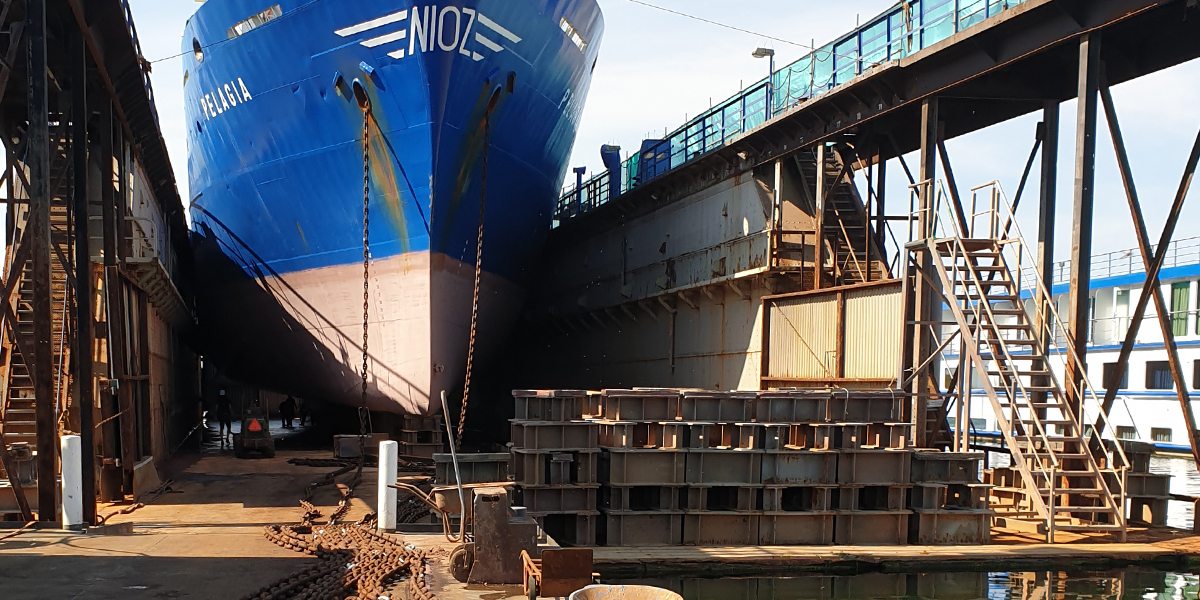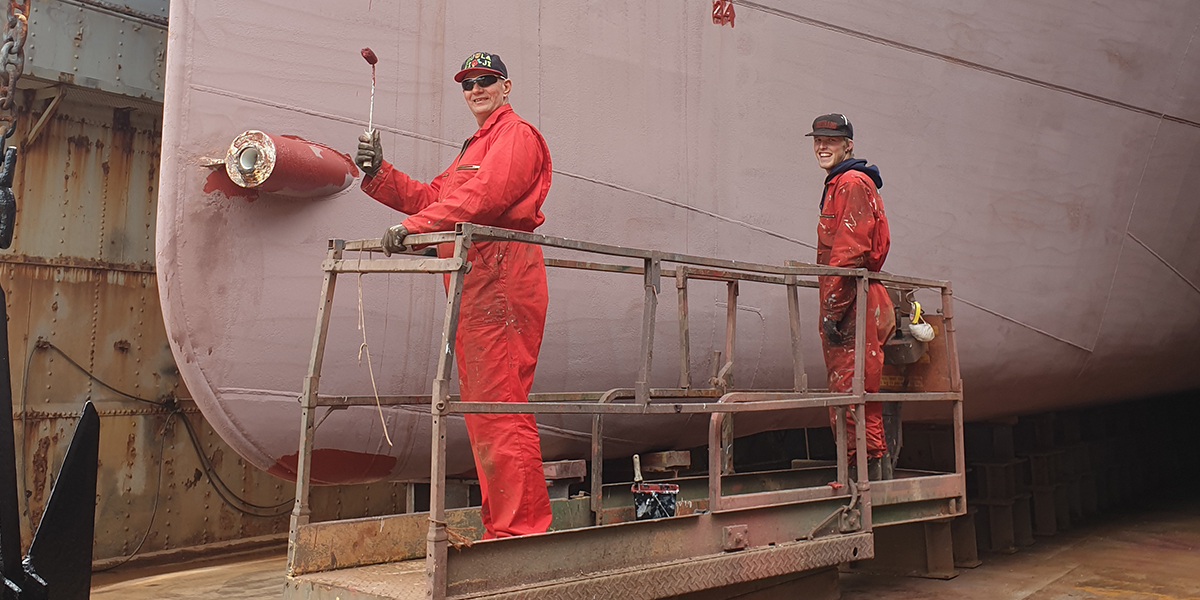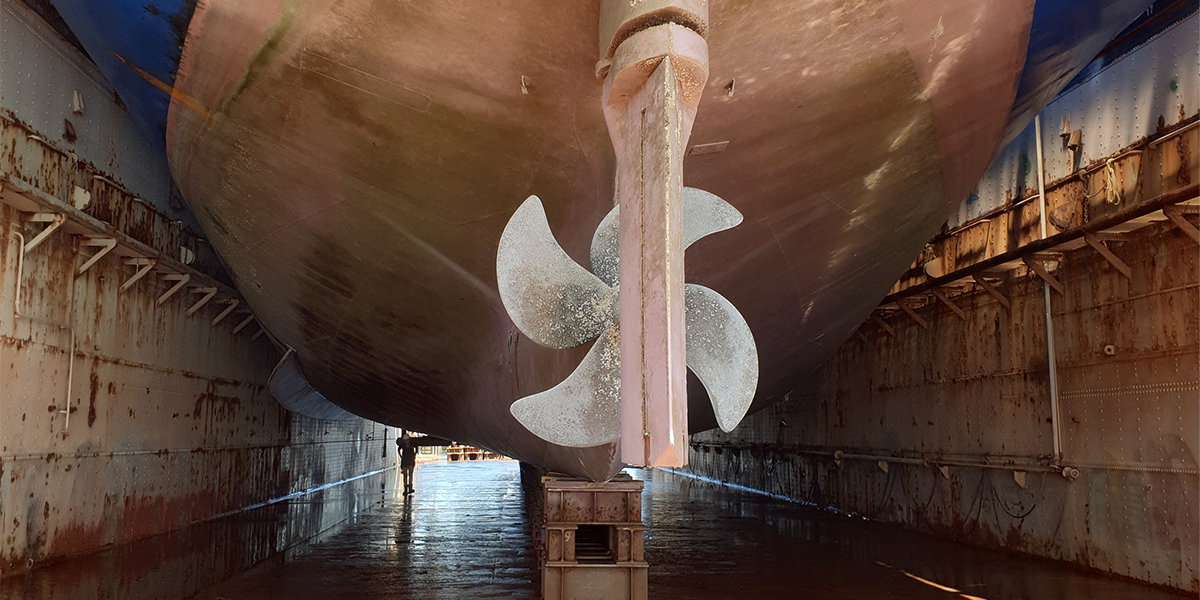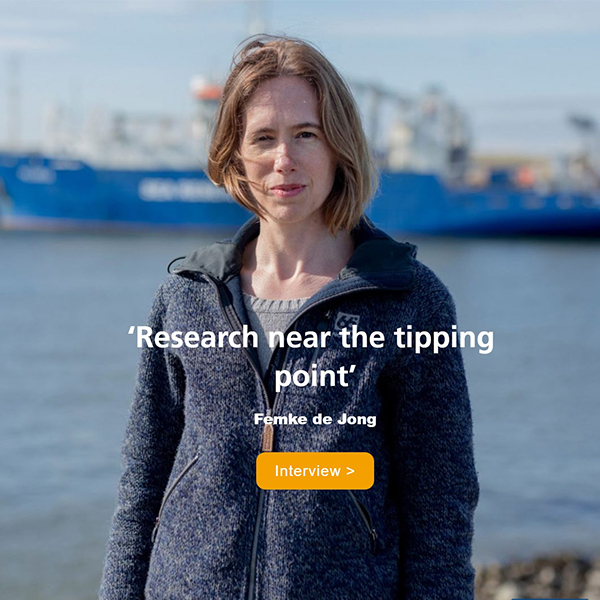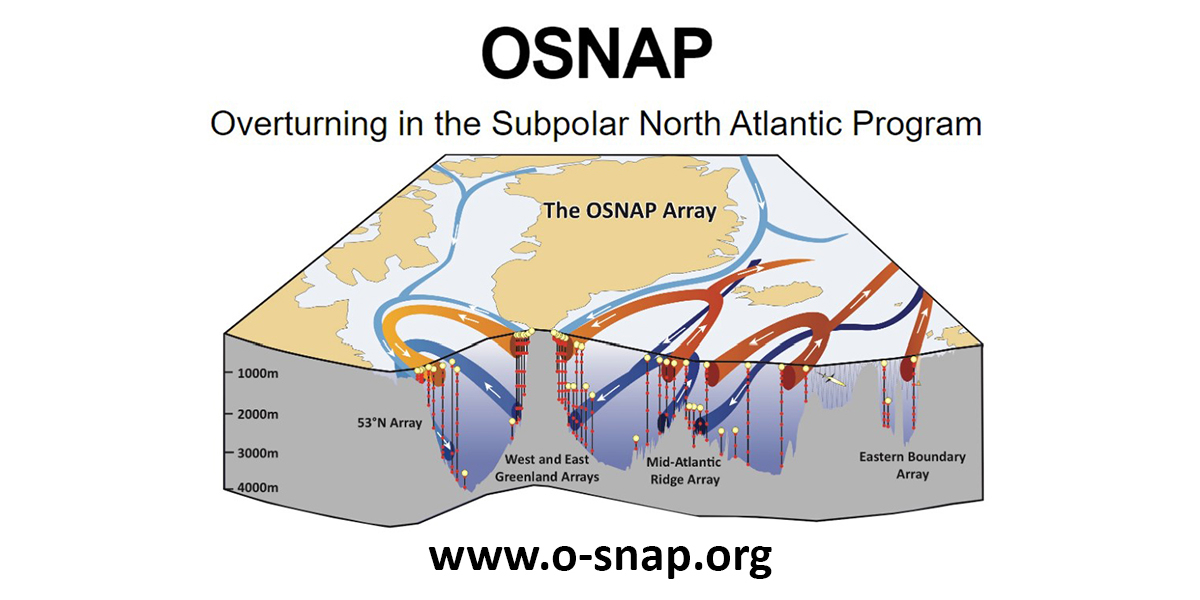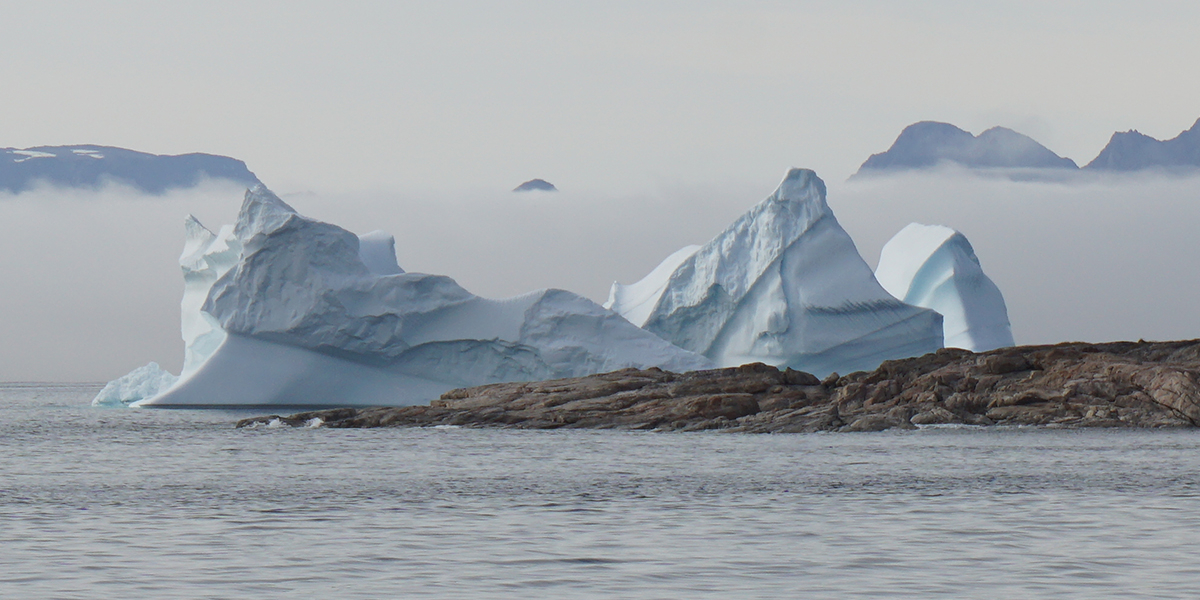
Sunday 16 August 2020 final blog.
By Femke de Jong - There and back again, a 4490 nautical mile round trip
We just arrived back where we started, on Texel, after 4490 nautical miles. So this is the end of our trip. It has been one of the initially most uncertain and intensive organization wise, but in the end very successful and even fun. We have talked a lot about the science and activities on board, but in this post I’d like to thank the people in our corona fellowship who made this possible. Especially for the crew, as many of them live abroad, in exotic countries like Bangkok, Argentina and Thailand, and some of them will not be able to go home today like we are because of quarantine regulations there. Nevertheless, they were motivated to make this trip a success.
Top crew
Our freshly promoted master Len, also known as captain Jack Sparrow, did an excellent job. He was supported by second officer Bridge Peter (“komt wel goed”/it will be allright) and third officer (and murder master) Jolanda. Our most experienced bosun Cor led the work on deck, organized by mooring master Leon and supported by (always happy, even when injured) Tall Peter and (old cable collector) Short Peter. Engineers Bert and Fred worked in the engine room and came up with creative solutions to our blackout problem and as well as any fridges that broke down during the storm. Sven maintained our science workhorse, the CTD and could also be relied on for any Formula 1 news. Alex, our cook, did his best to provide us with nice meals every day, even though his stores were running out quickly. He was supported by other Alex, who keeps the ship tidy very quietly and efficiently and never complains about it.
Thanks also to my two PhD students, Elodie Duyck and Nora Fried, who supported me during the preparations and the cruise itself. To the three MSc students; Rick de Kreij, Fleur Wellen and Niek Kusters, who all joined at the very last minute when it became clear that our US collaborators could not join. And finally to NIOZ, for doing everything to make this cruise happen.
Sunday 16 August final blog
By Fleur, Niek and Rick - The student experience
We are the small group of students who joined the research cruise. In this blog we would like to talk about our perspectives of the cruise, and what we enjoyed the most.
Before diving into our highlights, we would first like to talk about what we, as a group of students, have in common. To start with, we are all master students at a technical university, with a large interest in ocean fluid mechanics. Before the cruise, we did not know each other, even though Niek and Fleur are doing the same study in Delft. Another thing we have in common is that we have never been to NIOZ before. And lastly, compared to the rest of the research crew, we have never been on a research cruise.
Joining the research cruise
Despite our lack of sea experience, we all immediately knew we would love to get on board of the Pelagia for the research cruise to the Irminger Sea. Not that we had any plans for the summer, but if we had them, we would throw them all overboard to be able to join the research cruise. We as students experienced multiple highlights during the cruise. Within the upcoming sections we explain our perspectives.
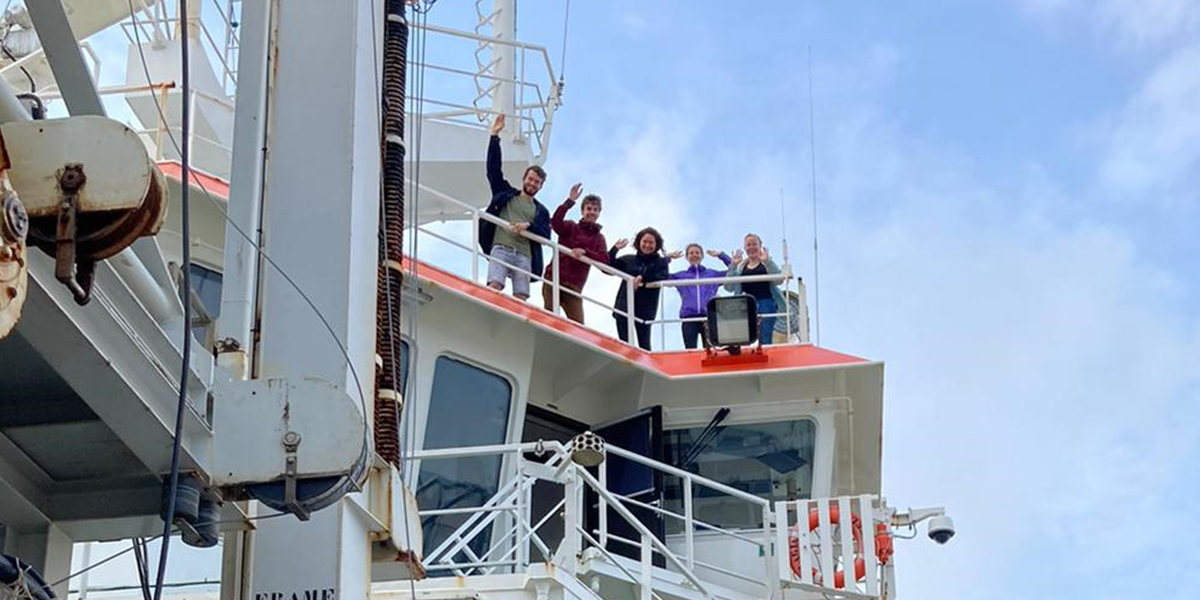
Niek: 'Cool to see how the real world relates to the theory that you study.'
It is unnecessary to say that the past few weeks have been a real unique experience. It was really cool to see how the real world relates to the theory you have studied during your studies. But it also gives you some sense of reality when you are for example working with a computer model. In that case it is really easy to just change some numbers and change some settings, but you can easily forget that in the real world, those same numbers can represent the same distance of half the ocean which you can cover in a week of steaming with a research vessel. Or the amount of CTD’s which are necessary to make the cross-section plots with for example temperature or salinity data.
Never a dull moment
Although every day on board follows a similar pattern, every day had its interesting moments. Whether it was a visit from another vessel in the middle of the ocean, or we were visited by another group of pilot whales or dolphins again, or the strange deep-sea biology you can find on the landers and moorings we recovered. There was never a dull moment on board and the view never stops to amaze.
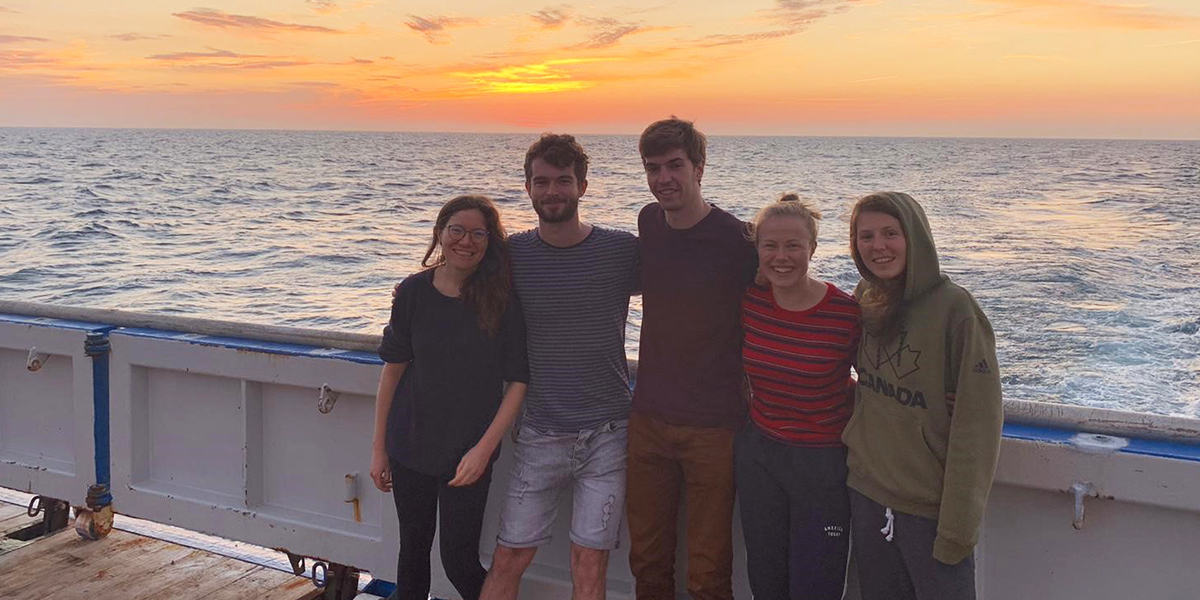
Rick: 'Life at sea amazed me every day.'
For me, it all started a couple of months ago with my internship at NIOZ. The internship focused on estimating mesoscale mixing from moorings located in the Irminger Sea. Due to Covid-19, the internship was arranged in such a way that it could be carried out entirely from home. I worked together with Femke, Nora and Sjoerd, who I only saw through video calls.
At one moment I received a mail from Femke, with the topic: 'Possible internship on the spot?'. I never did dare to ask whether I could join a cruise, and yet, there it is: the opportunity to join the research cruise to the Irminger Sea. From the first moment on I knew it for sure, count me in! During my internship, I used the data from the moorings which we serviced during this cruise. Before the cruise, I did not have an understanding of how much effort went into obtaining the mooring data. But now I know how much preparations are required to analyze a part of the Irminger Sea, leave alone the post-processing. The amount of work should definitely not be underestimated.
And now, here we are, at the end of a 5-week research cruise to the Irminger Sea. For me, it is the most impressive experience I have ever had. It is an experience hard to express on paper, but, believe me, it is something you will never forget. Life at sea amazed me every day.
Fleur: 'From 'textbook' science to real-life.'
For me this trip has been special from the start: 10 weeks ago I would not have imagined to be on a research vessel in the middle of nowhere for 5 weeks. The most impressive part was to see how my ‘textbook’ science concerning the ocean, discussed during 2 courses in my Masters, is created in real-life. All nicely coloured ocean sections discussed during my Physical Oceanography course are created by real research vessels, steaming in desolated areas, lowering a metal measuring device with multiple bottles to the ocean floor. Now I fully understand all the hard work behind these figures and the amount of people you need to just take one sample from the depths of the ocean depth.
Overall the life on board surprised and suited me. I really enjoyed meeting new people and getting to know them. Everyone had their own (cruise) stories to tell and both the crew and science party were eager to help us. And if you wanted a moment alone, you could just walk outside and enjoy the sound of the wind and waves (and the engine, although you do not register this anymore after some days).
Thank you all!
The Corona situation at home made this trip even more special. We created our safe heaven on board for the past 5 weeks. This could not have been possible without the lovely crew of the RV Pelagia. Thank you all!
Finally we would like to thank Femke, for taking us on this special trip in these special times. We have learnt so much in little time and we are grateful to have been part of this mooring/drifter/CTD adventure. We would also like to thank Elodie and Nora, the PhD students, for answering our numerous questions about the data, cruise stories or other (non)related matter.
Friday 7 August
By Femke de Jong - Final pieces of the cruise puzzle
A few days ago we finished deploying the last mooring and recovered the last lander. The most intense work may be done, but we are not home yet. While we still have time we are trying to complete the hydrographic section along the OSNAP line. We started this section on the east Greenland shelf and ideally we finish the line at the Scottish shelf. However… we have to be back on Texel before high tide in the afternoon of the 15th of August. Being late will not be appreciated (either on board or by the home front).
The last two days I’ve been puzzling with station locations, spreading them out along the line and recalculation the final arrival time. Unlike on other cruises, on which we typically run a 24-hour program in shifts, I have to limit the work to between 8am and 8pm. With our reduced crew and science party (to allow social distancing) we do not have the personpower to work round the clock. During the hours of 8pm to 8am we stay on position on the next station, or if the waves and weather are calm, we drift a bit to save fuel. This felt very unusual in the beginning, and a bit of a waste of time, but this is the way it is.
What we would like to have is a complete (west to east) temperature and salinity cross section of the Atlantic at this latitude. The area of deep water formation in the central Irminger Sea, a research interest of mine since my first cruise here in 2003, was covered in the beginning of the cruise and we are now heading towards the warmer, saline Atlantic Current. These sections have been done nearly annually since 1990 and they nicely show the evolution of water masses in these basins over the years. From the cold 1990s to the warmer mid-2000s and again cooling towards the mid-2010s. We are curious also to see the impact of a fresh body of water first seen to move around the subpolar gyre a few years ago.
However… there comes a point when recalculating with wider station distance and skipping an extra station or two (worth an hour or two each) doesn’t save enough time anymore to get home before our deadline. We will have to start steaming off the line and towards Texel before we reach the end of the line. Just a few more CTDs please…
Monday 3 August
By Nora Fried - Mooring work in the Irminger Sea
Five years from now I had my first research cruise. Back then I was still in my Bachelors and everything was new and very exciting. Three cruises and around 35 moorings later I’m still getting fascinated by mooring work, especially when they are coming up.
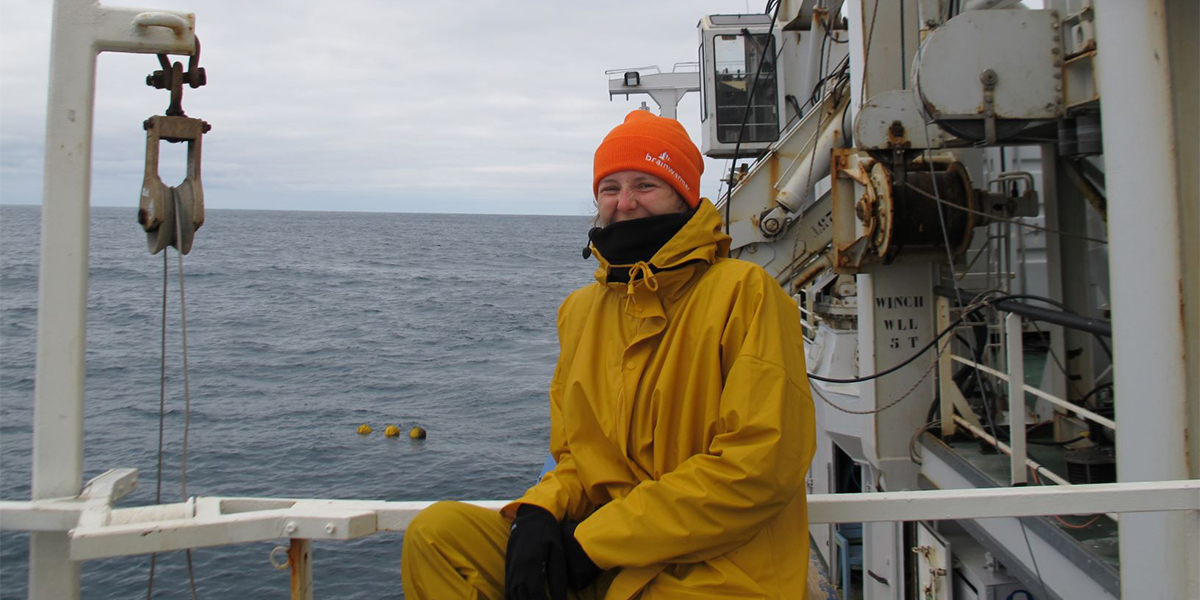
On this Pelagia cruise we are servicing the NIOZ moorings in the Irminger Current on the western side of the Reykjanes Ridge. They are part of my PhD project which makes it especially exciting for me. The moorings are also part of OSNAP (Overturning in the Subpolar North Atlantic Project) and are serviced by NIOZ every two years. They were first deployed in 2014, meaning that after processing this year’s data we will have a six years long record of data in the Irminger Sea.
The Irminger Current transports warm and salty water at the surface as a continuation of the North Atlantic Current, and cold and dense overflow waters at depth. It flows northward along the ridge following the cyclonic circulation of the Subpolar Gyre. The Irminger Current itself is part of the Atlantic Meridional Overturning Circulation (AMOC) and it belongs to the upper limb. One characteristic of the Irminger Current is that it consists of two cores and a southward recirculation at depths. Those two cores are very variable in position and strength. Finding out about the Irminger Currents mean state, variability, its pathways along the ridge and its contribution to the AMOC is part of my PhD project.
Since more than a week now we arrived in the mooring area and could successfully recover and redeploy already three of our moorings. The moorings are all equipped with various instruments: MicroCATs, Thermistors, ADCPs and current meters. MicroCATs measure conductivity, temperature and pressure and if you ask Fleur they look a bit like a glue gun. Thermistors can measure temperature at 5 min intervals and are tiny instruments that are fixed to the cable with the most important tool on board: yellow tape. ADCPs and current meters both measure velocities. Current meters return measurements at one depth while the ADCPs are upward looking and can measure velocities at different depths. In our moorings the ADCPs capture the upper 450m up to the surface.
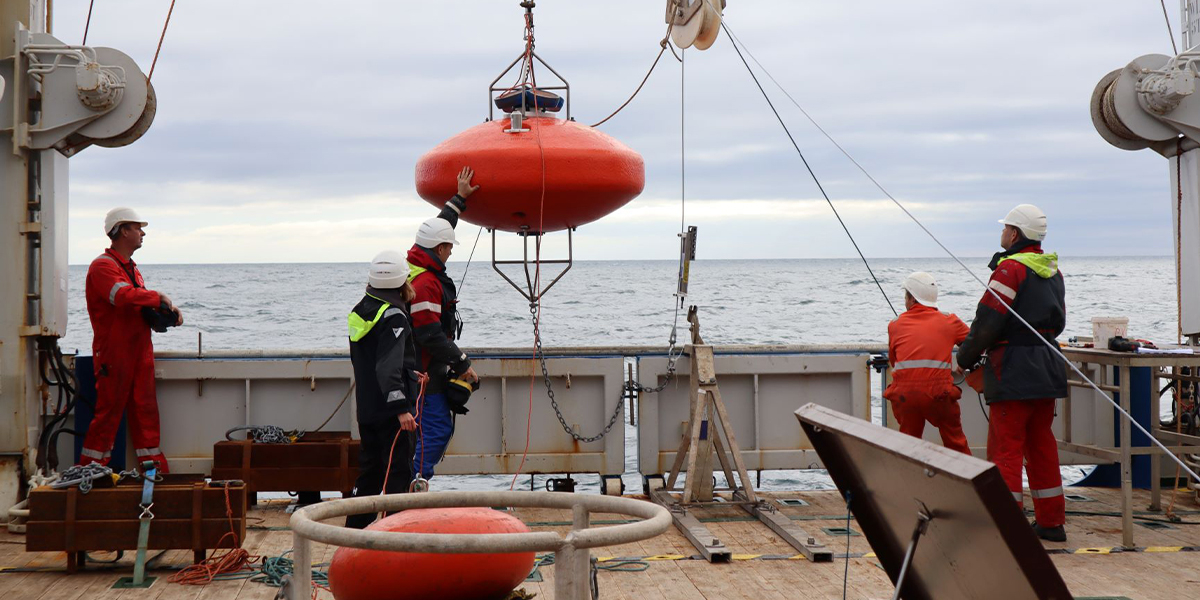
So, the last days we were busy with cleaning and reading out instruments. In some cases, we restarted them and equipped them with new batteries to send them back into the waters for the next two years. Nothing would be possible without our experienced crew on deck who make sure that every instrument comes safely on board. And not to be forgotten the help of our three master students who are very motivated to help even if it means spooling up cable for two hours or cleaning the instruments with a dishwashing brush.
Today (01.08.2020), we will redeploy IC3 which is ~1600m deep and right in the eastern core of the Irminger Current. After this, we still have one mooring to go until we continue our CTD section along the OSNAP East array and then finally head back to Texel.
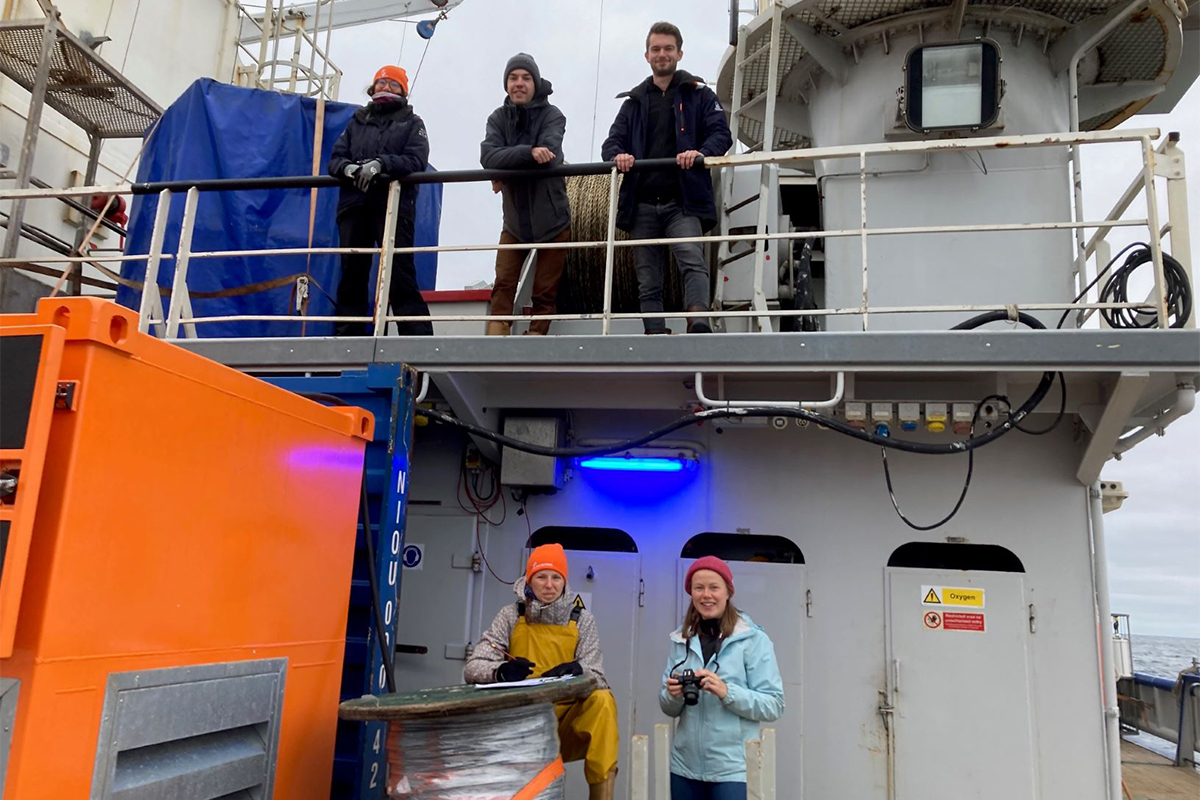
Wednesday 29 July
By Fleur Wellen - CTD stations and sightseeing at sea
Life continues on board, we now live from recovering one of the five moorings to CTD and from CTD to re-deployment. Time flies when one is having fun!
Apart from the recovery and redeployment of moorings, the deployment of drifters, CTD’s are our main job every day. The CTD measures conductivity, temperature, depth, and oxygen. Using this data one can make a distinction between different water masses. Along our route we do a CTD every so many nautical miles, which in the end provides us with a ‘section’, meaning we can see the different water masses in the Irminger Sea between Cape Farewell and the Mid Atlantic Ridge.
CTD’s:
Just as important are the CTD’s near the location of the moorings as they provide calibration data for the smaller CTDs mounted on the moorings. As they have been in the water for approximately 2 years some instruments can start to ‘drift’. Which does not mean they float away, but that their measurements can slowly become less accurate in time. The data has to be corrected for this drift.
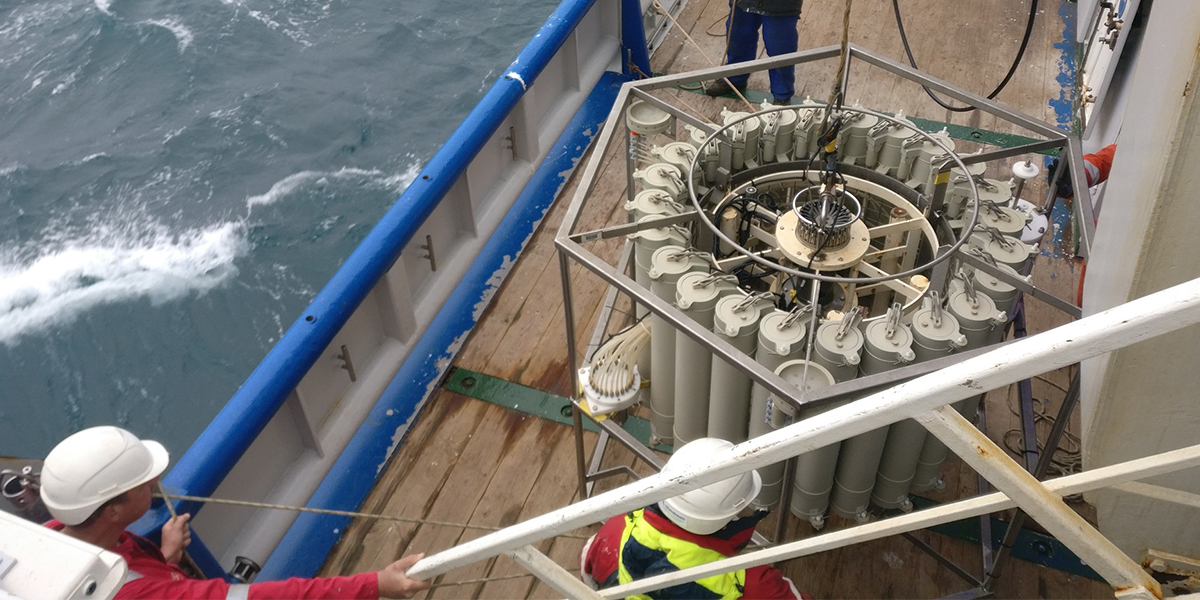
The measuring device, we use to call THE CTD, is a metal frame with in the middle the different measuring sensors. These instruments are surrounded by 24 bottles, each of which can be closed by command when it is at a designated depth. Firstly one prepares the CTD, check if all bottles taps are closed and the system is ready to be lowered into the deep ocean. There is contact between the bridge, the deck and the CTD monitoring room at every stage of the CTD measurement, using Walkie-Talkie’s (also called Talkie Walkie by some). Secondly, we (the science party) return to the CTD monitoring room, on deck the deck team lowers the CTD into the water (‘Hij mag over de muur’). We turn on the sensors of the CTD and check the bottom depth. If all instruments work, the system is slowly lowered to the bottom of the ocean, which can take quite some time as at some locations the bottom depth is more than 3 kilometers. The system provide us with real-time data, so we can see the temperature, salinity and pressure changing as the system keeps going down. For the ocean or water enthusiasts: one can even distinguish for instance thermoclines and pycnoclines.
Once the CTD is 10 meters above the bottom of the ocean floor, we look at the temperature, salinity and oxygen profile that was created on the way down. We decide at which depths we want to close bottles as to take a water sample at specific depths. We tell the deck to go up to a specific depth, there we wait for a minute to give the water column time to settle and with one click we close a bottle. Imagine the CTD hanging on a thin metal wire 3 kilometers below the ship and when we ‘fire’ a bottle, the command travels down the wire and deep down a bottle closes. After all water samples are taken and the CTD is at the surface, the deck crew lifts the CTD on deck. Than the fun starts for us. We take both oxygen and salinity samples using the bottles containing the water samples of specific depths. For oxygen it is important that no air is present in the bottle and this is quite a tedious job. Using two different chemicals, lots and lots of shaking and a rubber band one assures no air reaches our sample nor oxygen can leave the bottle. These samples will be measured back home at Texel. The salinity bottles need to be thoroughly rinsed, meaning filling, shaking and emptying the bottles three times, before we can take an actual sample.
Water from deeper parts of the ocean is quite cold and can reach temperatures of around 1 degrees Celsius, meaning your fingers and hands will definitely freeze when you are sampling oxygen and salinity. Also, it is quite beneficial if one wears a rain coat. After all the samples are taken the bottles need to be emptied and this quite often ends in splashes and pools of water on deck. Luckily we do not mind doing the sampling, it is actually real fun and you feel like you are really contributing to science.
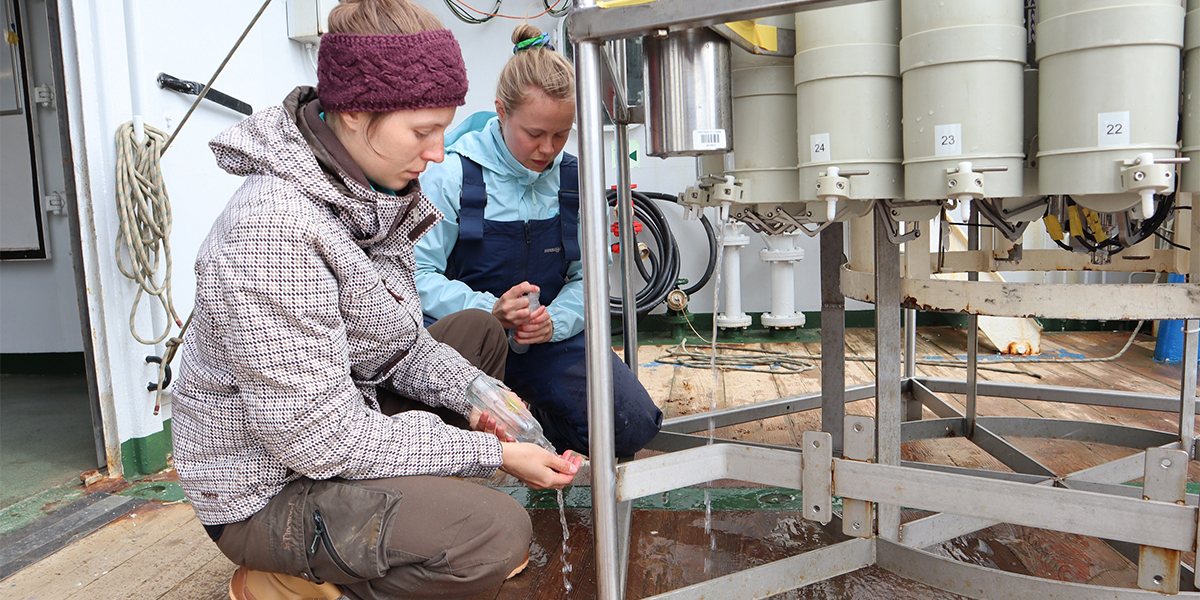
Sightseeing
Greenland is supposed to be quite mountainous with 2 kilometer high cliffs, although we cannot tell you if this is correct as Greenland was hidden in thick fog when we arrived at our closest position to the coast. We saw some small islands appearing through the fog and even managed to spot a faraway iceberg using our binoculars.
You may wonder how is the rest of the sightseeing? Well, as you might have guessed the ocean looks quite empty at the surface especially in this part of the world. However, numerous animals live in this ocean and we have been wanting to spot whales or dolphins for multiple days. After deploying one of the last drifters we finally saw some sea animals close to the boat: two fin whales (length is approximately 25 meters and one can recognise the small fin on the back) and multiple pilot whales (much smaller and with bigger black fins – Grienden in Dutch).
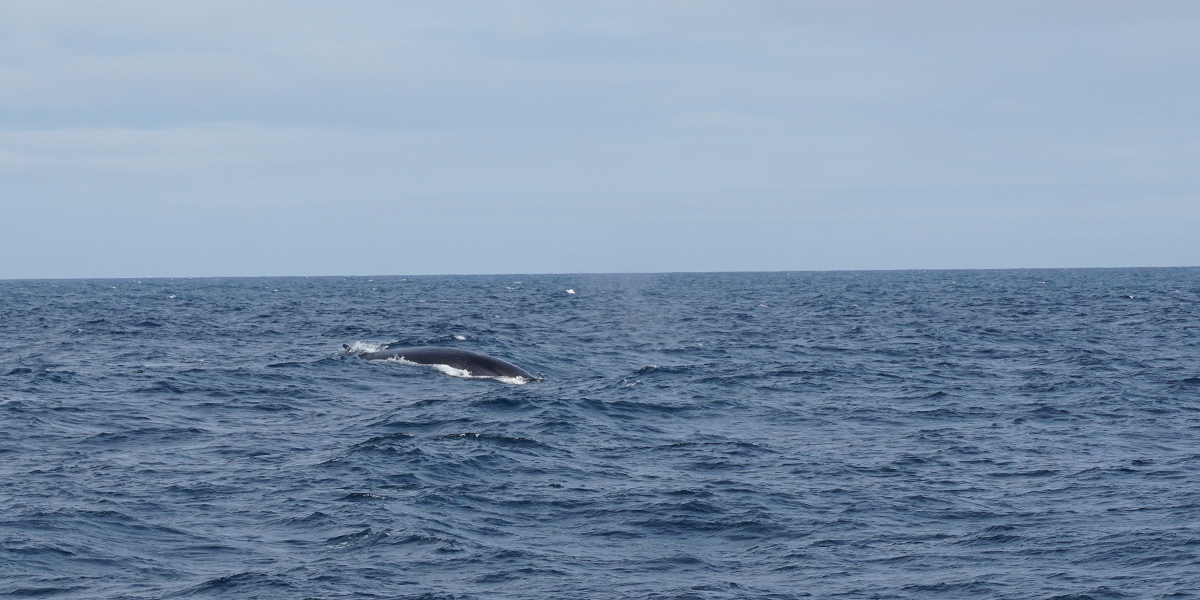
Something very excited happened in our middle of nowhere, another research vessel approached us. The RV Neil Armstrong was also working on the OSNAP array and decided to wait for us on their way back home to the United States. It was truly exciting to see a sign of a life in this desolated part of the world, our first ship in a week. A small MOB boat was released by the RV Neil Armstrong and three of their crew members approached us for an exchange of words and gifts. The Americans were very generous and gave us multiple Neil Armstrong goodies and for everyone on board special Neil Armstrong sticky (plak) tattoo. We returned the favour and they were delighted, with amongst other things, the Dutch stroopwafels. The Neil Armstrong goodies were distributed amongst the crew and science party members of the Pelagia using a fair and organised lottery. (Corona masks can apparently also be used as a blindfold!)
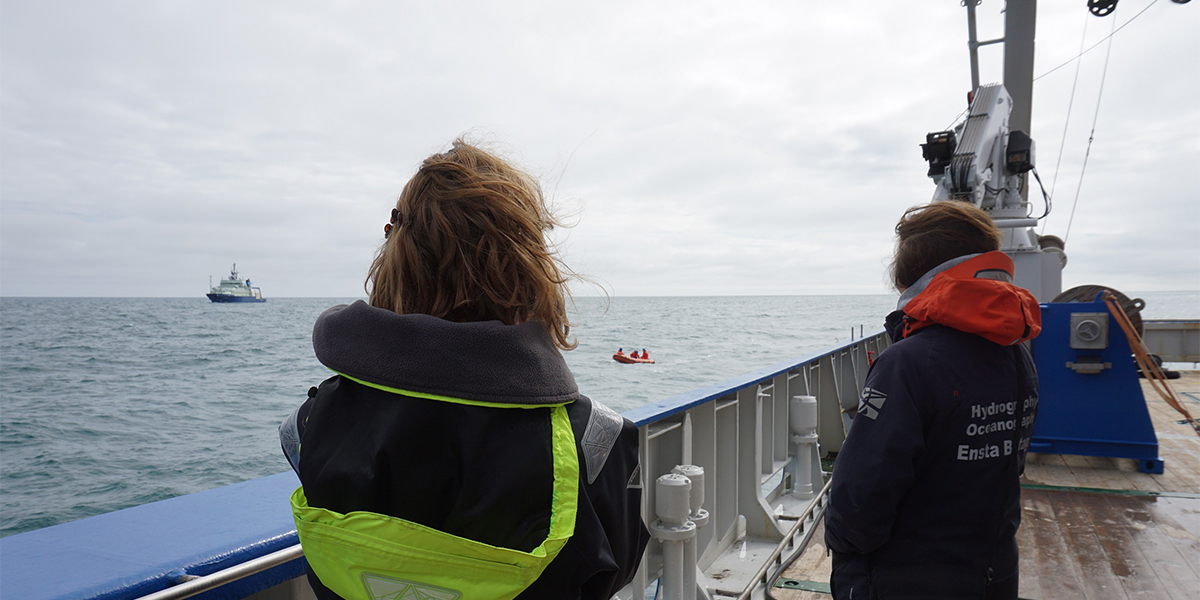
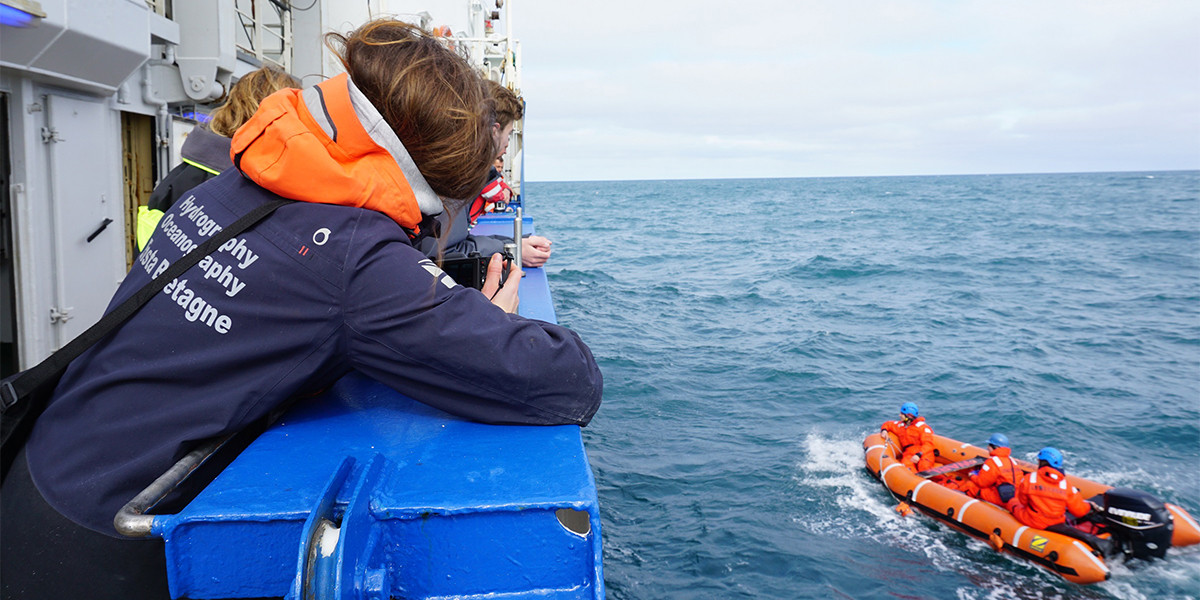
Monday 27 July
By Elodie Duyck – Drifter deployment
Last Sunday, 30 drifters - surface buoys that follow ocean currents - were standing on the Pelagia back deck. On Monday, they were all deployed in the East Greenland Current, near the southern tip of Greenland. But why are we following surface waters in that area?
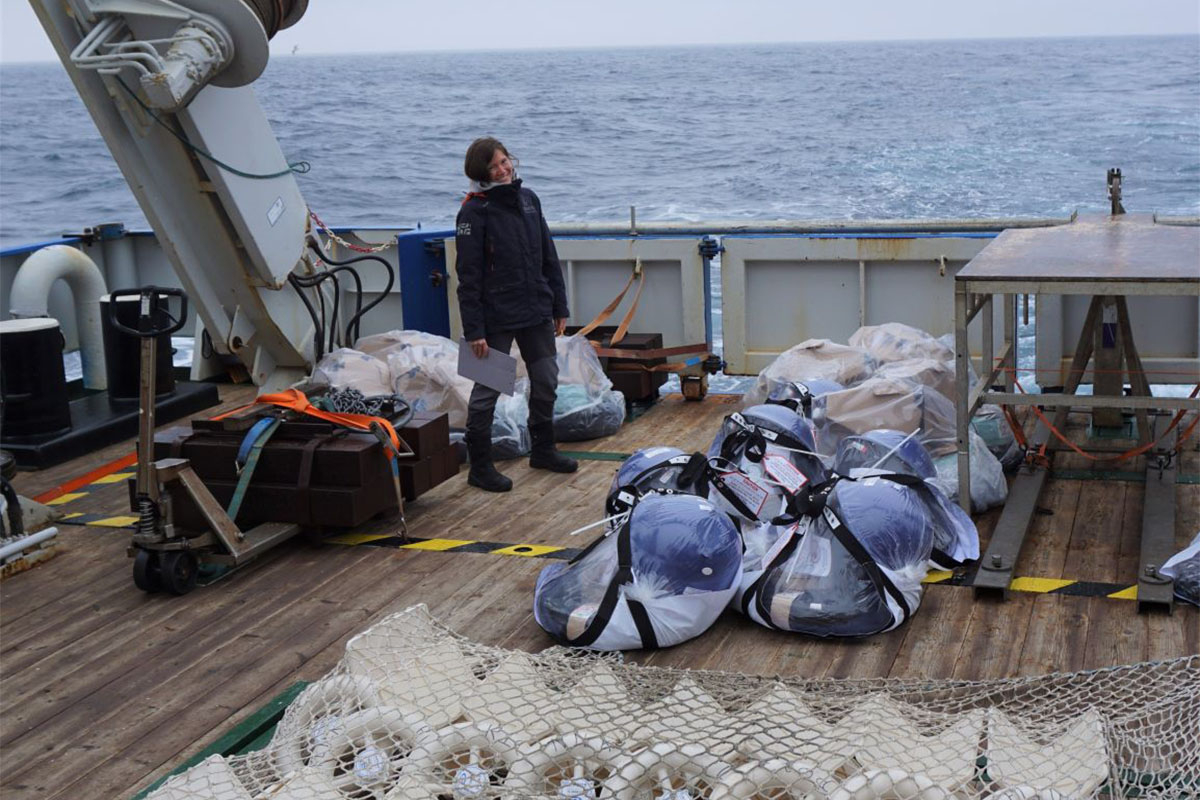
The region known as Subpolar North Atlantic (see map), is of particular importance for the ocean circulation as a whole. Deep winter mixing in the cold and stormy northern seas (Such as the Irminger and Labrador seas), causes cold water to densify and sink. This process is known as deep convection, or deep water formation. As Femke explained in her 16th July post, this newly formed deep water then flows southward, as part of the Atlantic Meridional Overturning Circulation (or AMOC). Because it ensures heat redistribution between the poles and the equator, the AMOC is a key element of our current climate. In the recent years, more and more studies have focused on its stability and how it could be disturbed by climate change.
One particular risk under investigation is the effect extra freshwater input in deep convection regions could have on the AMOC. Indeed, as the planet heats up, the Arctic ocean is freshening and the Greenland Ice Sheet is melting at a record rate, leading to increased discharge of freshwater into the East Greenland Current – EGC on the map -. If this extra freshwater is exported from the East Greenland Shelf towards deep convection regions, it could increase the surface stratification, making winter mixing more difficult, and potentially weakening the overturning circulation. However, it is still unclear whether fresh waters get exported away from the shelf, and in which quantity. This is what we are trying to uncover by deploying drifters in the East Greenland Current: Can we track export of fresh surface waters from the East Greenland shelf into the Irminger Sea? If yes, what are the mechanisms allowing for such export?

Drifters are surface buoys composed of a floating device and an anchor that ensures they follow waters at a specific depth. They are tracked with GPS and can transmit their position, but also water properties such as temperature and salinity, in real time. On this cruise, we are deploying 30 drifters near Cape Farewell, the southern tip of Greenland. We have two different type of drifters: Surface Velocity Program (SVP) drifters are composed of a spherical buoy and a long “Holey sock” drogue, that opens when they are in the water and anchors them at 15 m depth. CARTHE drifters are smaller buoys, made of biodegradable bioplastics. They consist of a floating torus and two interlocking panels that anchor the drifter at 40 cm.
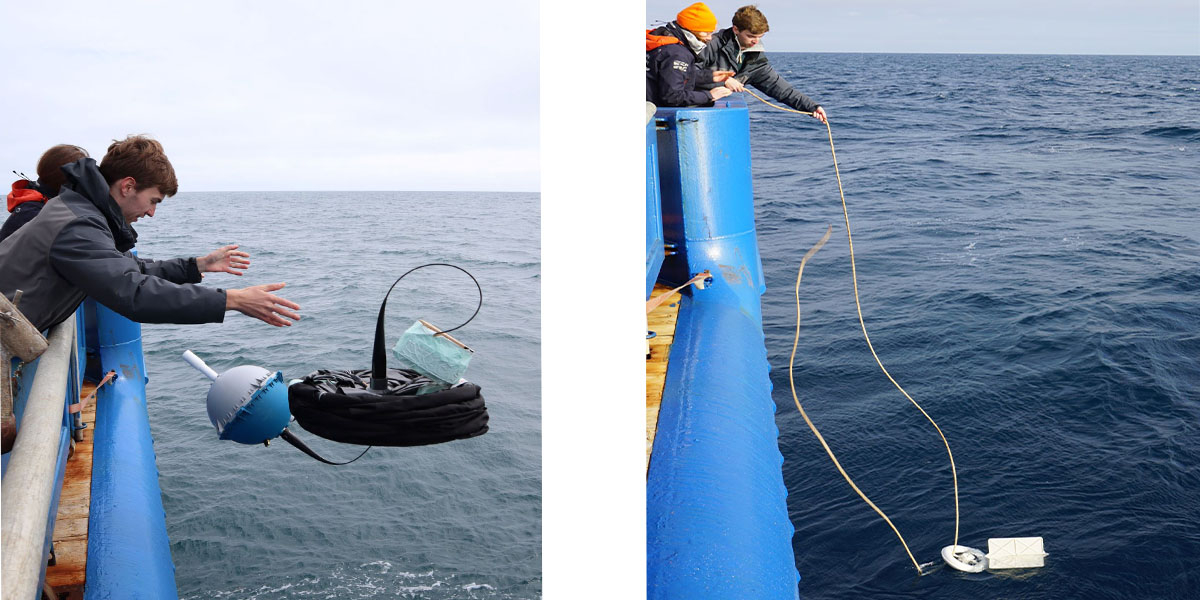
On the morning of Monday, 20th July, we started deploying pairs of CARTHEs and SVP drifters into the core of the East Greenland Current. We checked that all of them were working, and that we were already able to retrieve data. SVP drifters were dropped from the back deck into the waters, while the more fragile CARTHE drifters were carefully lowered with a rope. By the end of the day, the deck was clear and all drifters were in the water, already sending real time data with their trajectories and water properties. Over the next year, we will be following them to learn more about the circulation in the area.
Sunday 19 July
By Niek Kusters - Final preparations
On Thursday 16 and Friday 17 July we were able to enjoy the Northern Atlantic Ocean during strong winds, and with these strong winds, you will get the big waves for free. So, with the Pelagia stamping and rolling over the 7 meter waves, everyone on board was able to enjoy the extra challenge that comes with all those extra dynamics of the ship. Everyday activities suddenly become much more challenging. Sleeping in your bed, walking through the corridors or sitting on a chair, everything becomes a bit more difficult. One would think that on a ship, everything is extra secured for situations like this. But it is surprising to see how many items are still loose and get a life of their own; sliding and rolling through the room, or cupboards making surprisingly much noise with glassware falling over (don’t worry, it didn’t break).
Starting with a dip
Luckily, after two days being locked inside, the weather improved on Saturday. The wind was less strong, a pleasant 5 Beaufort, and the waves were much lower. So, after a good night sleep, we could continue with the testing and setting up the equipment, something we started in the first few days. Today we did a test CTD (Conductivity, Temperature, Depth). After a short explanation on deck of all the sensors and equipment on the frame, we went up to the CTD-room, where computers show the values of the sensors and the equipment can be controlled. The first part of the testing was to lower the entire frame to a depth of 50 meters. The bottles on the frame for water samples should be opened by the extra (water)pressure. To be sure, we did this initial dip in the water and get it back up. Now the system was ready to be lowered all the way to the bottom of the ocean.
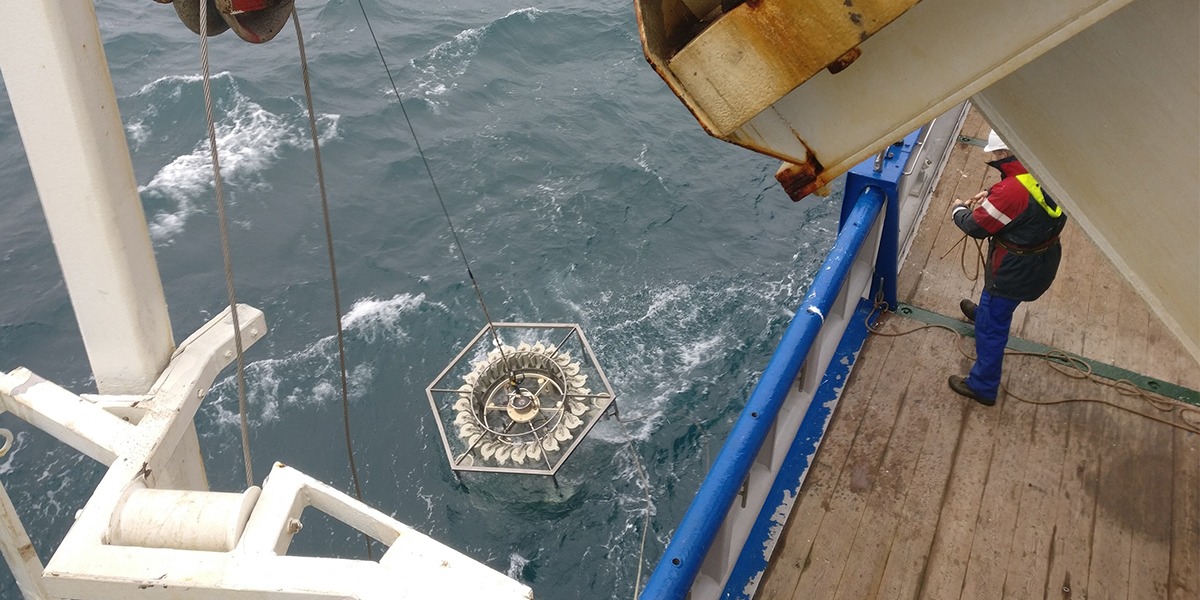
On its way down, the sensors on the frame measured a profile of amongst others temperature, salinity and density, which we could see again on the computer screens. On the way back to the surface, the frame was stopped at a few different depths. Here the water bottles were closed, so that water samples from that depth can be brought to the surface for further analysis. Once back on deck, the water from the bottles can be tapped into smaller flacons. Something you might not realise is that the water sampled at the bottom is at a much lower temperature, only 2 or 3 degrees Celsius, while the water at the surface is currently a ‘warm’ 9 degrees Celsius. After all, this was a nice test run with the CTD to get acquainted with the entire procedure and sampling. In the coming days we can put these skills to good use, as there a quite a few CTD’s planned.
Drifting fast and far
Today, on Sunday 19 July, the preparations on the drifters continued. For the duration of the transit they were stored in the ship, which prevents them from sending any signals. Today all the drifters have been placed on deck, so that could be checked if they were all sending GPS signals. Also all the drifters have been named after all the persons on board. It was nice to see how some of the crew started to cheer up and encourage the drifters with their names on it to drift fast and far. Tomorrow the transit from Texel to Greenland will come to an end as we reach our destination Cape Farewell. It is nice to finally get started and we will see how all the preparations will pay off.
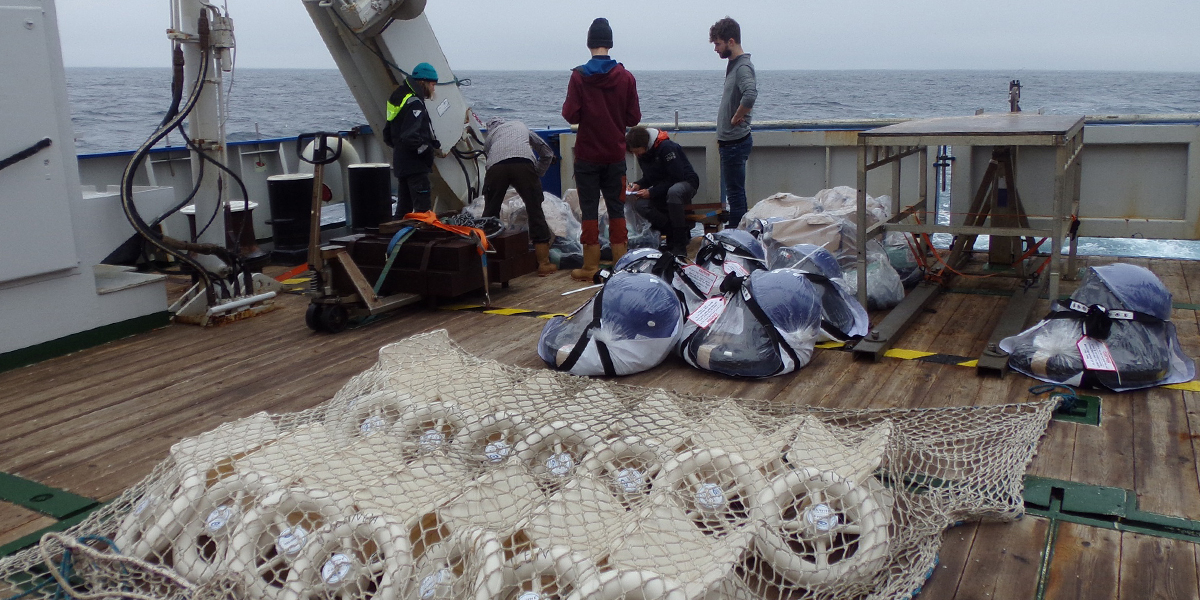
Thursday 16 July
By Femke de Jong - Why are we out here?
Today we are enjoying the rollercoaster that is the North Atlantic during strong winds. To be honest, I’ve seen a lot worse out here. Mid-summer is still the best time to be here wind and ice-wise. But why do we go out to this windy, cold place year after year, rather than enjoying our summers on a nice warm beach somewhere?
You may have heard about the Gulf Stream, a warm current off Florida that transports warm water from the tropical Atlantic to the north. This well-known current is part of a larger, less well-known larger scale circulation called the Atlantic Meridional Overturning Circulation. The “meridional” refers to the north-south direction, as we are interested in the net transport from the equator to the subpolar and polar areas. The “overturning” refers to the vertical component, what goes north at the surface must be converted (overturned) into deeper waters that move back south so that water does not pile up at one side of the Atlantic. The temperature and salinity difference between the warm, salty northward flowing surface waters and cold, fresher deep southward flowing waters creates a net northward heat and salt transport. This northward heat transport is also important for our climate on land. We aim to understand how and why this transport of water, heat and salt changes through the years, so that we can better predict how it may change further as a result of climate change.
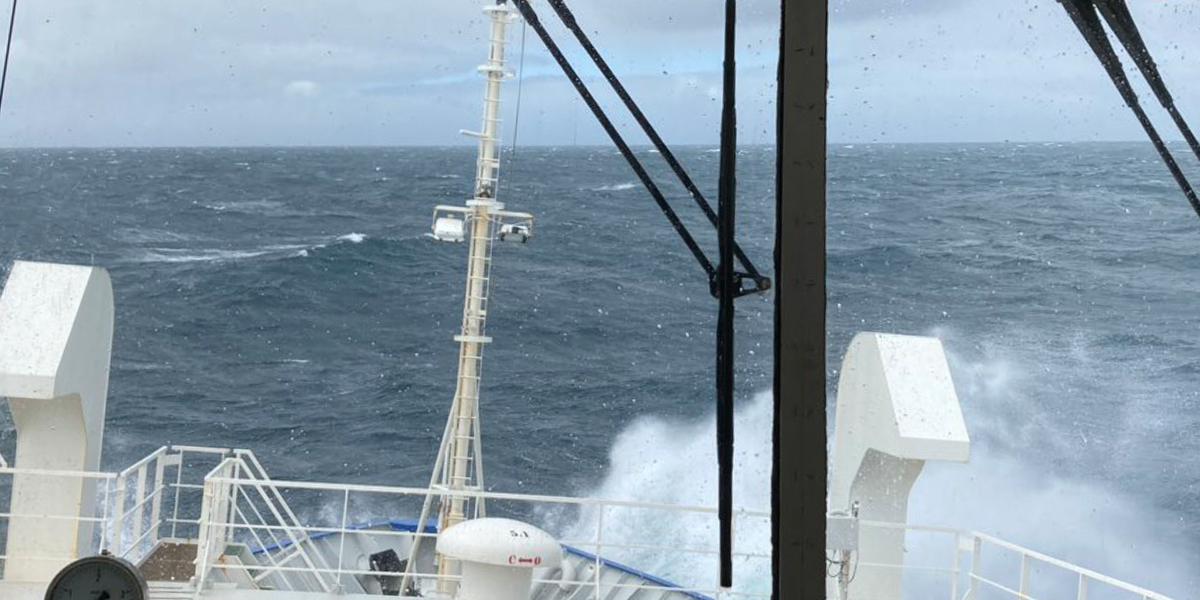
53 Moorings between Canada and the European continental shelf
My first cruise in 2003, as a student, also went to the Irminger Sea. At the time, basin-wide cross sections of temperature and salinity were done nearly every summer to observe how the subpolar North Atlantic changed through the years. However, over the last decade we have learned that the circulation varies on much shorter time scales, from day-to-day and from month-to-month. So, what you measure during a month-long ship survey is representative of that particular month, but not necessarily for the whole year. A rising awareness of this lead to a change in observing tactics. We now have instruments in the water that measure water velocity, temperature and salinity year-round (every hour or 15 min depending on the instrument). These instruments are deployed on moorings, long cables anchored to the seafloor and kept upright by floatation units/underwater buoys.
Together with several international institutions we observed the circulation over the whole northern North Atlantic in the Overturning in the Subpolar North Atlantic Program (OSNAP, www.o-snap.org). In total, 53 moorings are located between Canada, Greenland and the European continental shelf. We go out with our research vessels once every two years to recover these moorings. We download the data from the instruments, replace their batteries and redeploy them on new moorings at the same locations. This cycle started in 2014 and we are now going out to recover years 5 and 6 (2018-2020) of this time series. I am keeping my fingers crossed in hopes that everything worked as expected, but I will not know until all instruments are recovered and the data is downloaded and checked.
Social distancing at sea
In other years we were at sea together with some of our OSNAP colleagues. We share shiptime as much as possible in order to keep the whole program affordable. In 2018, our NIOZ team was a guest on board the American research vessel Neil Armstrong. This year one of the America teams, who maintain moorings close to ours, was planned to join us on RV Pelagia. However, the corona pandemic waylaid these plans. We are now out here with a reduced science party, 6 scientists/students from NIOZ and the Netherlands, so we can socially distance at sea (max 2 people per lab, one way routing in corridors, lunch/dinner split over two groups). Our 6 American colleagues will go on the RV Neil Armstrong later this year from its homeport in Woods Hole, so that they do not have to travel internationally.
We also changed our start and end port from Reykjavik, Iceland, to our homeport on Texel (with a 2-week home isolation before). As a result, we have a long transit with 9 days of steaming to our first station off Greenland instead of 2 from Reykjavik. But we are happy to be able to be out here to continue our time series, as many of our oceanographic colleagues have completely cancelled or severely delayed fieldwork. Sea-going oceanographers are very much used to adjusting to circumstances (weather, ice, problems with instrumentation) and making the best of it and we are motivated to do as much as we can this year as well.
Wednesday 15 July
By Rick de Kreij
We are almost halfway to Cape Farewell. We passed through the Northern Isles on Monday afternoon. These Northern Isles are a pair of archipelagos off the north coast of mainland Scotland. The passage had a strong counteracting current, therefore it took a bit longer to get through the passage, giving us more time to admire the stunning coastline of Scotland. We were close enough to the coast to have cellphone connection, therefore, last phone calls were made before we headed off into the North Atlantic Ocean.
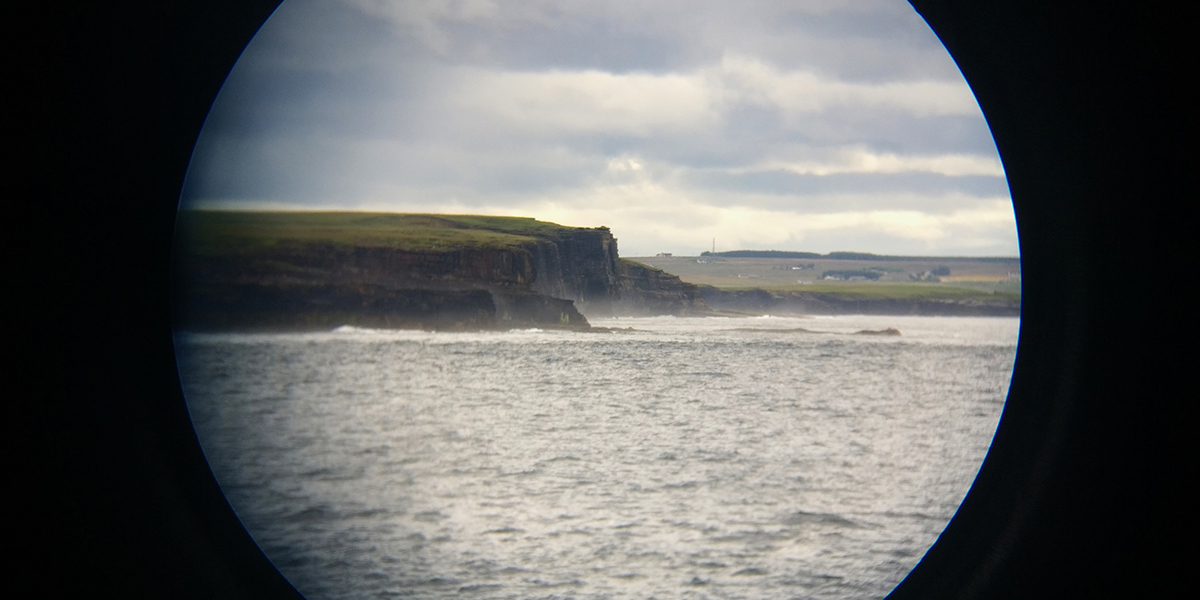
Preparing measurement devices
Once in the North Atlantic Ocean, the weather changed; the wind got stronger and the waves got bigger. Luckily, we were already used to the waves, so the symptoms of seasickness were not that severe. We did a double check to make sure that all equipment was safely stored.
During the journey to Cape Farewell we have enough time to prepare the measurements. Each day we prepared a different measurement device. On Monday we looked into the new velocity measurement devices (Aquadopp current meters) and on Tuesday we tested the data recovery of the Aanderaa RCM-11 current meters. We also started with sampling for the salinity calibrations and we assembled all the CARTHE drifters.
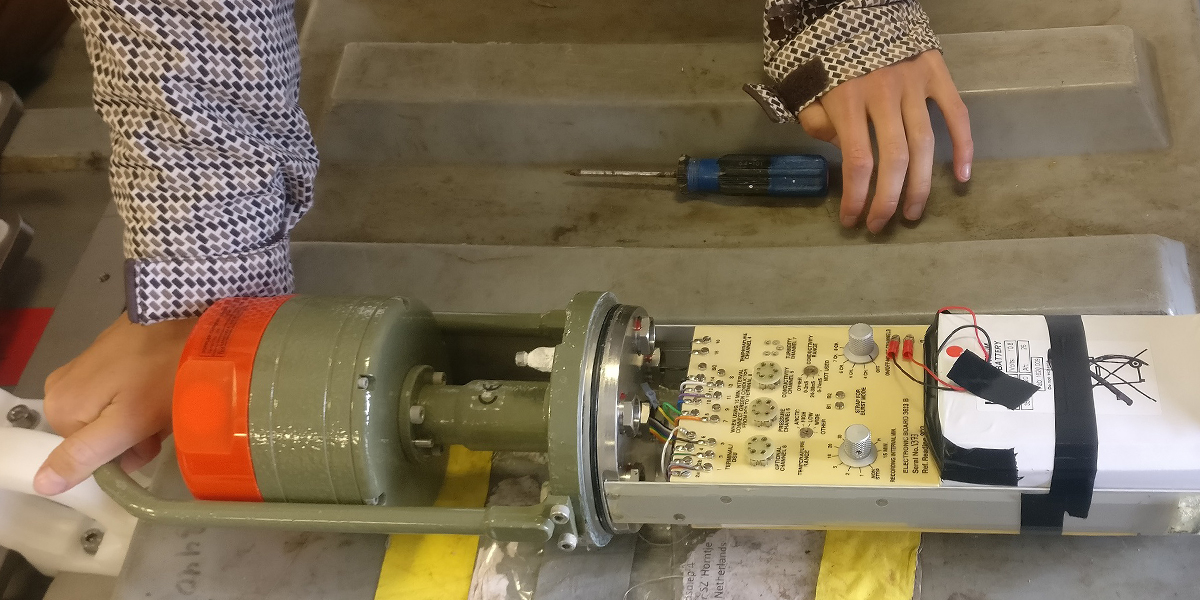
Presentations, cards and more preparations
Each evening one of the scientists gave a presentation to share their knowledge about the Irminger Sea and the relevant measurement devices. On Monday evening Nora presented her PhD study about the Irminger Current, focusing on the variability observed from the moorings. Yesterday evening I presented my internship study also about the Irminger Current, focusing on mesoscale mixing at the moorings. These presentations might be followed up by a very challenging game of cards, as we have seen yesterday evening.
In the upcoming days we will spend our time to further prepare the measurement devices. And, something we do all the time, is to enjoy the view and the work we are able to perform here in the middle of the ocean.
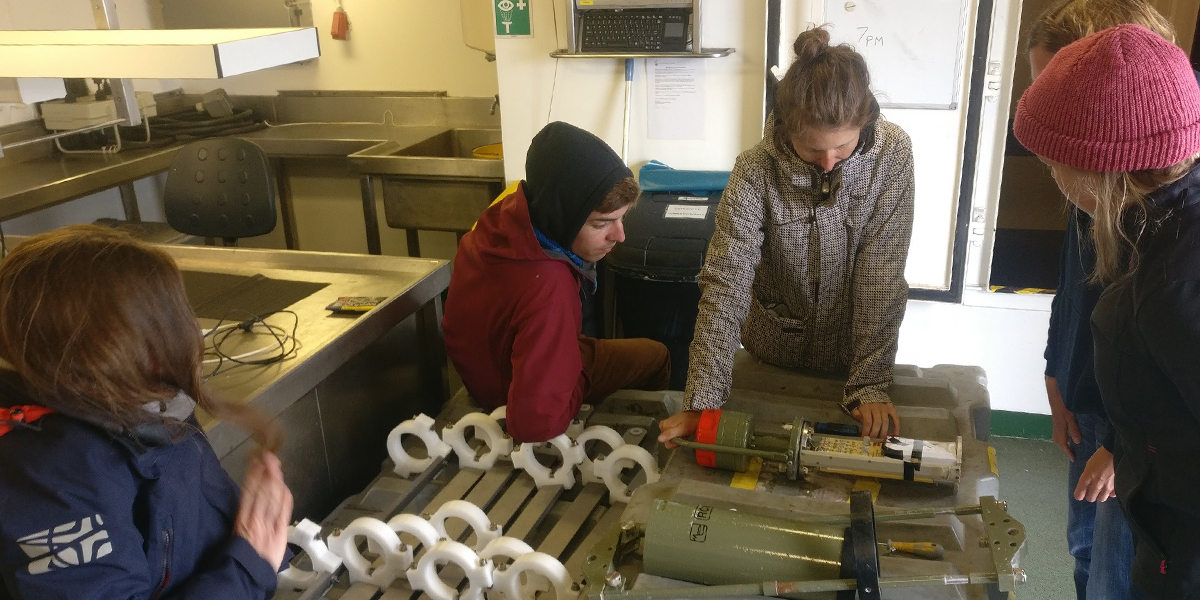
Sunday 12 July
By Fleur Wellen
After two weeks of self-isolation we finally left for Cape Farewell. Last Friday we met the entire crew and our fellow scientists and after safety instructions we slept on the RV Pelagia in the NIOZ harbour. Saturday around noon we left the harbour to set sail. The weather was perfect and we had a clear view of Texel, Den Helder and later the Razende Bol. Some people on small sailboats waved us goodbye. And the last living things we saw were the seals chilling on the sand delta.
After we were fully on our way, a safety drill was used to get everyone acquainted with the safety protocols on board. In the evening we enjoyed a good and healthy dinner and an interesting presentation of Femke about the general focus of the research trip. Whilst discussing the final questions the lights suddenly went out, the ship slowed down and slowly stopped moving. We were experiencing a black-out. The technicians looked real calm and set off to the engine room to take a look. In the meantime the other engine (apparently there are multiple engines on one ship) was started so we could continue cruising.
Soothing rocking of the sea
The first night on board at sea you are still growing familiar with the movements of the ship. So the rocking forward and backward is on the one hand soothing, but you will wake with each unexpected movement. We were still lucky the sea was quite calm and the good weather continued today (fingers crossed we have this weather the entire trip). For me it is the very first time, so growing accustomed might take longer. However, all of the crewmembers are very friendly and have some tips to deal with for instance sea sickness (fortunately everyone is doing okay until now!).
Today (Sunday), after breakfast we unboxed some of the material and placed in the dry lab or the container containing workspace for the moorings. One should not forget that (especially during moments of bad weather) everything will start moving on a ship, so we had to fasten everything to the boat itself. This took some time and different strategies, but in the end we were satisfied with the result.
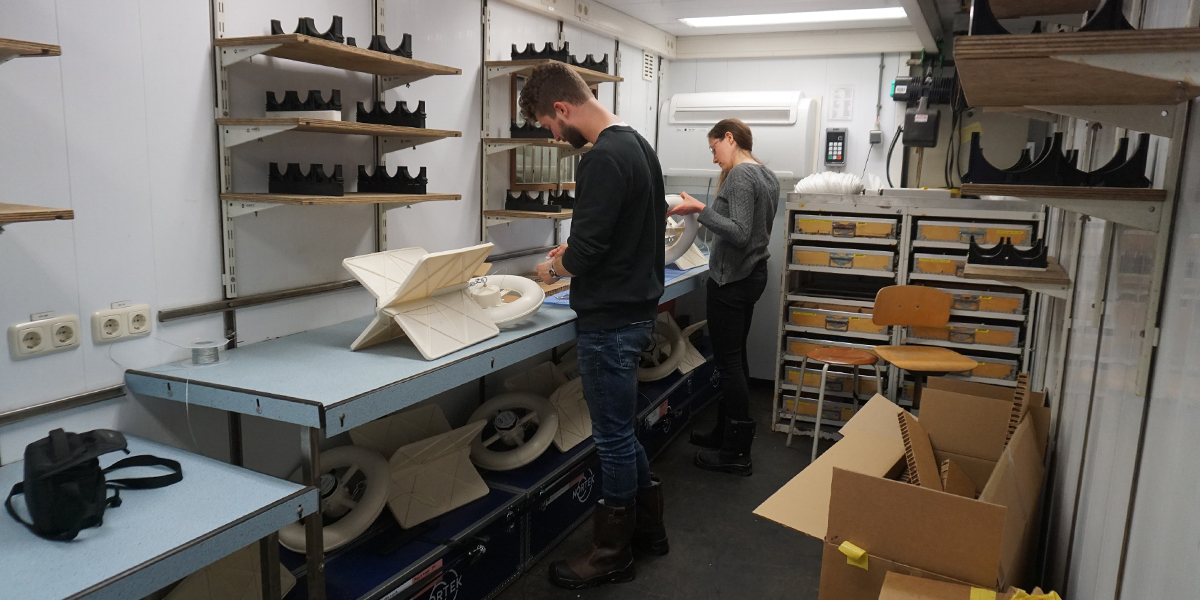
Special treat
After moving and lifting the equipment we were surprised to find special pastries (Soezen met chocolade, yummy!) in the mess room. Sundays are considered to be somewhat more special than other days on the ships, so the cook prepared these pastries the past day to surprise us. They were delicious! Sunday afternoon Femke, Elodie and Rick are looking at the assembly of the drifters. The rest of us is enjoying the sunshine and working on our own data/presentations.
Stay tuned for more updates on our trip!
Wednesday 8 July
By Nora Fried
Servicing moorings
Four days to go! This Saturday RV Pelagia will leave Texel to head for the southernmost tip of Greenland, Cape Farewell. During the cruise we will service the NIOZ moorings that are part of the OSNAP East array in the Irminger Sea. OSNAP (Overturning in the Subpolar North Atlantic Program) started in 2014 and is measuring the Atlantic Meridional Overturning Circulation (AMOC) transport across the subpolar North Atlantic. As part of that, NIOZ maintains 5 moorings on the western side of the Reykjanes Ridge. These were last serviced in 2018 and will be recovered and redeployed for two years on this cruise. The moorings measure the volume, heat and freshwater transport in the Irminger Current. Two French landers along the OSNAP line will also be recovered. In addition to that, we will survey the section with CTDs to get detailed info on the hydrography.
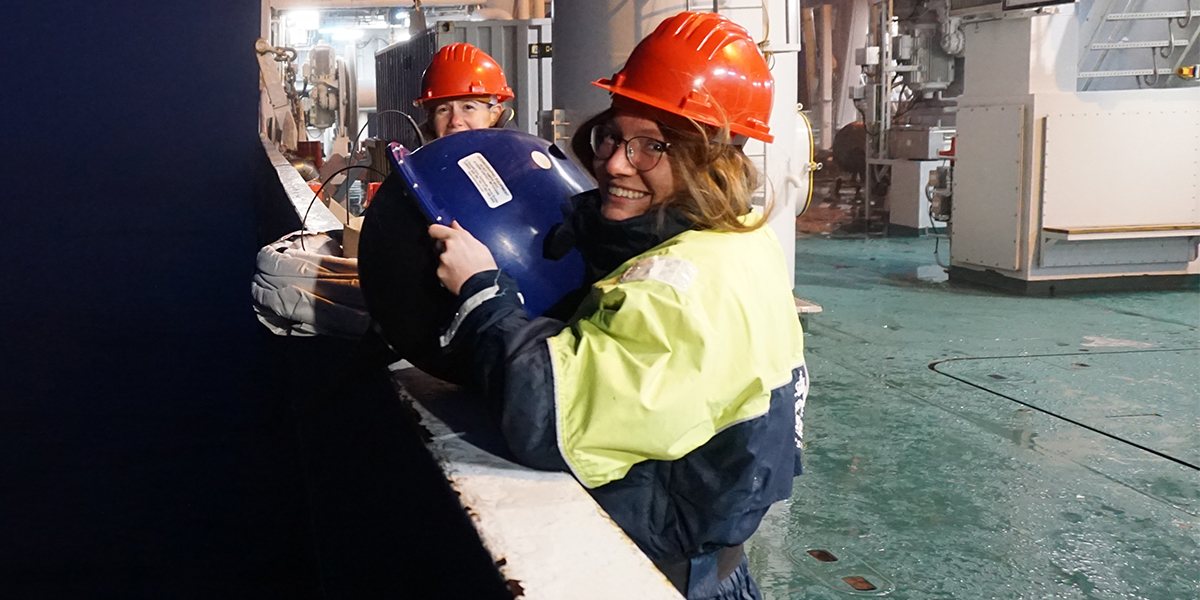
Drifters
Another focus of the cruise will be the drifter deployment on the southern tip of Greenland. This deployment belongs to the EGC – DrIFT (East Greenland Current Drifter Investigation of Freshwater Transport) campaign which looks into possible pathways for freshwater exchanges east of Greenland and is a follow-up on the deployment last summer.
OSNAP 2020 team
Due to the corona measurements the science crew was reduced by 50%. The physical oceanography team from NIOZ with Femke de Jong as chief scientist, her two PhD student Elodie Duyck and Nora Fried, and Leon Wuis as mooring technician will be supported by three students (Rick de Kreij from Eindhoven University and Fleur Wellen and Niek Kusters from TU Delft). The American team, who were originally planned to join us to recover their moorings as well, had to be rescheduled for the US vessel Neil Armstrong.
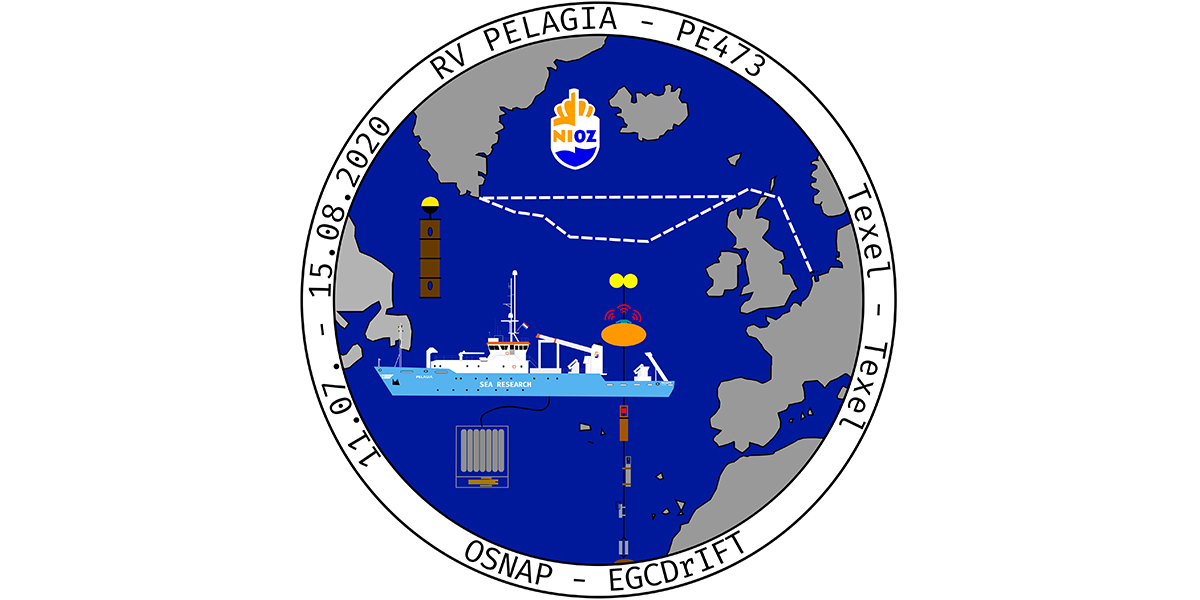
Tuesday 7 July
Five days to go! The expedition team had to pack early this year. All preparations were finished two weeks ago and right after, the team members went into self-isolation because of COVID-19 restrictions. For their own protection and that of the others, the crew will self-isolate until they set foot on board of RV Pelagia this Saturday.
Finishing touch
The RV Pelagia is almost ready to set course for the southernmost tip of Greenland: Cape Farewell. As the team sorts and packs the equipment, the ship receives some final technical and cosmetic finetuning in the docks of Oudeschild.
